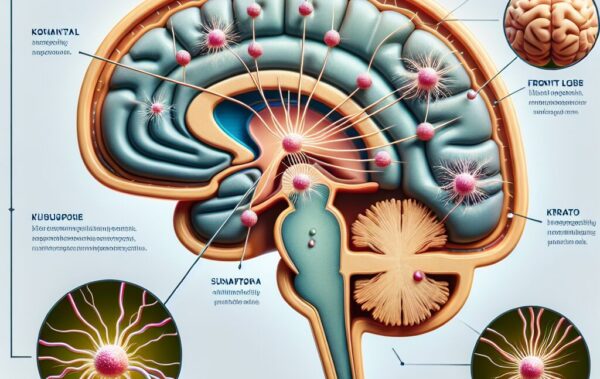Kratom, or Mitragyna speciosa, is a tropical evergreen tree native to Southeast Asia, where it has been used traditionally for its psychoactive properties. The leaves of the Kratom tree contain compounds with opioid-like effects, which has made this plant an increasingly popular choice in the search for natural alternatives to conventional anxiety medications.
As a potential herbal therapy for anxiety, Kratom has gained attention for its ability to influence mood and stress levels. The primary active compounds in Kratom leaves are mitragynine and 7-hydroxymitragynine. These alkaloids interact with opioid receptors in the brain, which can produce sedation, pleasure, and decreased pain, especially when taken in larger doses. At lower doses, Kratom has been reported to increase energy, alertness, and sociability instead of sedation.
People often turn to Kratom for anxiety relief due to its dual capacity for uplifting energy levels in small doses and inducing relaxation in larger amounts. Its natural standing as a plant-based substance adds to its appeal among those seeking pharmaceutical substitutes for anxiety.
Furthermore, the versatility of Kratom is evident in its various forms of consumption. The leaves can be chewed fresh, or more commonly, they are dried and ground into a powder, which can be used to make tea or capsules. Extracts are also available, which provide a more potent form of Kratom, such as tinctures or resin extracts. Each form offers different methods for integration into one’s lifestyle, which can be appealing for individuals seeking a tailored approach to managing their anxiety.
However, it’s essential to note that while Kratom may offer some benefits for relieving anxiety, it remains a largely unregulated substance. This means that the quality, purity, and strength of Kratom products can vary widely, and they are not approved by the FDA for medical use. Users exploring Kratom as a form of herbal therapy must do so with careful consideration and ideally, under the guidance of a healthcare professional.
Kratom vs. Traditional anxiety medications: A comparison
Navigating the realm of anxiety management, the debate often boils down to traditional pharmaceutical interventions versus natural alternatives. On one hand, conventional anxiety medications, such as benzodiazepines, SSRIs, and SNRIs, have a well-established track record in the clinical management of anxiety disorders. Benzodiazepines, for example, are especially known for their rapid relief of anxiety symptoms but carry a risk of dependence and withdrawal, among other side effects. SSRIs and SNRIs, while generally safer, can take several weeks to become effective and may also lead to various side effects.
Enter Kratom, a contender in the pursuit of natural anxiety relief. Proponents of Kratom for anxiety argue that it provides an alternative pathway for those who have had varied responses to pharmaceuticals or seek an herbal therapy that aligns more with a holistic lifestyle. The advantage of Kratom, as opposed to conventional anxiety medications, lies in its multi-faceted approach that can be tailored to individual needs. At low doses, Kratom may invoke mild energizing and mood-enhancing effects, potentially countering the malaise and lethargy that often accompany anxiety. Across the spectrum, higher doses are reported to foster calmness and relief from anxiety, bearing sedative qualities without the use of traditional sedatives.
In concert with these effects, the appeal of Kratom also encompasses its lesser potential for addiction compared to certain traditional medications like benzodiazepines. However, this is not to suggest that Kratom is without risk or that it is appropriate for all users. Potential dependency, tolerance, and withdrawal remain concerns that underscore the need for careful, informed use.
Another point of comparison is accessibility and regulation. Prescription anxiety medications are subject to stringent FDA oversight and require a healthcare provider’s prescription. In contrast, Kratom, being unregulated, allows individuals to self-determine their use, which necessitates a heightened level of self-education and responsibility. Meanwhile, the variability in Kratom’s purity and concentration can be problematic, although trustworthy vendors strive to provide lab-tested, high-quality products.
From a legal and societal viewpoint, Kratom occupies a gray area where it is legal in some places and banned in others. This patchwork of legality adds another layer of complexity for those considering Kratom as a treatment option. Conversely, traditional medications hold a more universally accepted status despite their potential side effects and the risks of dependency and withdrawal.
- Conventional medications are clinically proven but may have significant side effects and risks.
- Kratom offers a natural form of relief with a dualistic effect based on dosage.
- Addiction potential exists for both but is commonly highlighted for pharmaceuticals.
- Regulation and accessibility vary widely between traditional medications and Kratom.
To summarize, Kratom’s viability as a substitute for anxiety medications depends on personal circumstances, including individual responses to pharmaceutical substitutes and the desire for a natural remedy. The herbal supplement’s multifunctional influence on energy and mood levels can make it an attractive alternative, but it demands prudent use and a good understanding of its properties and effects. Those interested in exploring Kratom’s potential must prioritize sourcing pure and consistent products, perhaps starting with Kratom capsules or a more controlled form such as Kratom shots, to ensure a measured intake under advisement from a healthcare professional.
How to use Kratom for anxiety relief
To use Kratom effectively for anxiety relief, it’s important for individuals to understand how to properly dose and administer the substance based on their specific needs. Kratom for anxiety can be approached with a sense of experimentation, as individuals often react differently to various strains and dosages. Here, we outline several key points to consider when using Kratom as a natural remedy for managing symptoms of anxiety.
When starting out, users are encouraged to begin with small doses to gauge how their bodies respond. A low dose typically ranges from one to five grams of Kratom powder or the equivalent in other forms, such as capsules or tea. At these quantities, Kratom may provide a mild stimulating effect that can help to relieve anxiety through enhanced mood and increased focus, without the sedation that larger doses may induce.
For those who require a more pronounced effect to alleviate their anxiety symptoms, moderate doses ranging from five to fifteen grams might be more beneficial. At such dosages, Kratom usually acts more like a sedative, creating a sense of calm and reducing the physical sensations associated with anxiety. It’s important to note that as dosages increase, so does the likelihood of experiencing side effects, which makes it imperative to find the lowest effective dose.
The mode of ingestion can also play a role in how Kratom affects an individual. For instance, consuming Kratom as a hot tea allows for a potentially faster onset of effects compared to capsules, which might take longer to digest. However, capsules offer convenient and accurate dosing, which can be helpful for maintaining consistency.
Choosing the right strain of Kratom is another key consideration. Different strains can produce varying effects, with some being more energizing and others more sedating. Generally, Red Vein strains are regarded for their calming properties and might be ideal for anxiety relief. Meanwhile, Green and White Vein strains can offer a balance of mild energy and mental clarity.
Here is a brief list to support proper Kratom use for anxiety:
- Start with a low dose and adjust as needed based on your response.
- Consider the timing of your dose; some prefer it in the morning for all-day relief, while others may take it in the evening to aid with relaxation.
- Drink plenty of water as Kratom can have a dehydrating effect.
Ultimately, close monitoring and adjustment of dosage ensure that users experience natural anxiety relief while minimizing potential side effects. In all cases, those looking to use Kratom for anxiety should consult with a healthcare professional beforehand, particularly if they have underlying health conditions or are taking other medications.
In terms of potential risks and considerations, the primary areas of concern revolve around legality, dependency, and interaction with other substances. While Kratom is legal in some regions, there are places where it is not permitted, making it crucial for users to be informed about local regulations. As with any substance that influences neurotransmitter systems, there is a potential for developing tolerance, dependency, or withdrawal symptoms with prolonged use. Therefore, regular breaks from Kratom, known as “rotation” or “cycling,” are often recommended to decrease these risks. Additionally, combining Kratom with other medications, recreational drugs, or alcohol poses serious risks and should be avoided.
To assist individuals in understanding their legal rights and responsibilities concerning Kratom, as well as for general information on safe practices, an info table is provided below:
| Category | Details |
|---|---|
| Legal Status | Varies by country, state, and local region; consult local laws. |
| Potential Risks | Dependency, tolerance, withdrawal, interaction with other drugs. |
| Recommended Usage | Start with low doses, rotate strains, take regular breaks, consult healthcare providers. |
| Type of Strains for Anxiety | Red Vein for sedation, Green and White Vein for mild energy and focus. |
While discussing the approach to using Kratom for anxiety relief, it’s imperative to integrate the understanding of Kratom’s properties and how they compare to pharmaceutical substitutes. The herbal therapy offered by Kratom constitutes a natural pathway for those pursuing holistic wellness practices. Its multifunctional attributes can complement a balanced lifestyle, often appealing to persons acquainted with herbal remedies and those inclined toward natural anxiety relief.
In the domain of natural wellness, quality is paramount. Sourcing high-quality Kratom that has been lab-tested for purity and consistency is crucial, as product variability can significantly affect efficacy and safety. Reliable Kratom vendors, such as those featured on Kratom.Markets, offer an array of kratom products that have undergone rigorous testing, ensuring that customers receive products that align with their therapeutic needs.
Potential risks and considerations for Kratom use
 Despite the potential benefits of using Kratom for anxiety, there are considerable risks and factors that merit careful attention before incorporating this herbal therapy into one’s anxiety management routine. It’s essential to recognize that Kratom is not a cure-all and should not be considered a first-line treatment for anxiety disorders. While anecdotal evidence suggests that Kratom can be beneficial for some users, rigorous scientific research to substantiate its efficacy and safety is still in its infancy.
Despite the potential benefits of using Kratom for anxiety, there are considerable risks and factors that merit careful attention before incorporating this herbal therapy into one’s anxiety management routine. It’s essential to recognize that Kratom is not a cure-all and should not be considered a first-line treatment for anxiety disorders. While anecdotal evidence suggests that Kratom can be beneficial for some users, rigorous scientific research to substantiate its efficacy and safety is still in its infancy.
The central nervous system effects of Kratom, due to its alkaloid content, are a primary concern as they can vary significantly from person to person. Mitragynine, the most abundant alkaloid in Kratom, acts on opioid receptors in the brain, which means there’s a range of side effects that could occur. These side effects might include nausea, dizziness, constipation, drowsiness, or more severe symptoms such as respiratory depression in the case of high doses. Therefore, responsible use of Kratom necessitates the understanding that one person’s therapeutic dose might be another person’s cause for negative side effects.
Kratom’s interaction with other drugs is another important consideration. It’s advised that individuals do not combine Kratom with pharmaceutical substitutes or other substances, especially central nervous system depressants, as this could lead to dangerous synergistic effects. Moreover, for those transitioning from traditional anxiety medication to Kratom, managing the cessation and onset without medical guidance can increase the risk of adverse reactions.
The lack of regulation surrounding Kratom cannot be overstated. The fact that it is not approved by the FDA for medicinal use means that there is no oversight regarding the standardization of dosing, purity, or content. Therefore, users must exercise due diligence when choosing their sources to ensure the safe use of this substance for natural anxiety relief.
Given the potential for abuse, it’s important for those suffering from anxiety to establish whether Kratom usage is genuinely beneficial for them or if it’s masking underlying issues that require different forms of intervention. Overreliance on any substance, regardless of its natural origin, as a primary method for coping with anxiety, can hinder long-term recovery and may lead to dependency.
Additionally, navigating the legal landscape where Kratom is concerned requires up-to-date knowledge, as its legal status varies widely across different jurisdictions. Being well-informed about the laws in your area ensures that you remain on the right side of the legal system while seeking herbal therapy for your anxiety.
It’s important to underline the contrast in potential dependency compared to benzodiazepines; while Kratom may have a different profile, dependency can still develop. Users have reported developing a tolerance to Kratom over time, meaning one may require larger doses to achieve the same effects. This can lead to a harmful cycle if not managed properly. Frequent users often practice cyclical usage or strain rotation to mitigate such risks.
Considering these points, it becomes clear that while Kratom offers a compelling alternative trajectory for those seeking relief from anxiety symptoms, it also invokes a set of challenges and responsibilities. Consulting with healthcare professionals, focusing on sourcing from reputable vendors, being vigilant about potential interactions with other drugs, and monitoring one’s own reactions to Kratom is paramount for those exploring it as a means for natural anxiety relief.
Below is a more detailed table outlining these considerations for Kratom use, aiming to provide users with a clearer understanding of the factors involved:
| Consideration | Advice |
|---|---|
| Purity and Quality | Only purchase lab-tested Kratom from trusted vendors to ensure safety and consistent quality. |
| Legality | Understand and adhere to the legal status of Kratom in your area before possession and use. |
| Dosing | Begin with the lowest possible dose and carefully assess your body’s reaction to the herb. |
| Dependency Risks | Be mindful of the potential for tolerance and dependence; consider cycling strains and taking regular breaks. |
| Interactions with Medications | Avoid combining Kratom with other medications or substances without medical advice due to interaction risks. |
The need for vigilance and responsible behavior when dealing with unregulated supplements such as Kratom is critical, especially when exploring it for conditions such as anxiety. It’s worth repeating that while some individuals may find relief using Kratom, the decision to use it should come after thorough personal research, professional medical advice, and an acute awareness of the associated health and legal risks.
Frequently asked questions about Kratom for anxiety
Frequently Asked Questions about Kratom for Anxiety
As the use of Kratom for anxiety becomes more prevalent, numerous questions emerge regarding its efficacy, safety, and legal status. Below is a compendium of frequently asked questions (FAQs) designed to provide concise answers for those seeking insights into the use of Kratom as a natural anxiety relief option.
1. Is Kratom effective for treating anxiety?
While individual experiences with Kratom for anxiety relief vary, some users report positive effects, such as a sense of calm and well-being. Currently, there is limited scientific research to categorize Kratom as a clinically approved treatment for anxiety, therefore its effectiveness is not guaranteed. Users often rely on anecdotal evidence and personal experimentation under the guidance of healthcare professionals.
2. What strains of Kratom are best for anxiety?
Typically, Red Vein Kratom strains are recommended for their sedative properties that may alleviate anxiety. Red Bali, Red Maeng Da, and Red Borneo are among the popular choices. However, users may also find relief with certain Green and White Vein varieties, which can offer a blend of mild energy and mental clarity. Exploring different strains helps individuals determine which variety works best for their individual needs.
3. How do I choose the right dosage of Kratom for anxiety relief?
Finding an effective dose involves starting with a small amount to observe how your body reacts. For Kratom newcomers, doses of 1-5 grams can be considered low and may provide mood-enhancing and energizing effects. Moderate doses (5-15 grams) are more sedative and might be better suited for severe anxiety. Adjusting the dose gradually while monitoring the body’s response is crucial for acquiring the desired outcome without overstepping into unwanted side effects.
4. Can Kratom be used alongside pharmaceutical substitutes for anxiety?
Due to the potential for interaction with other drugs, it’s strongly recommended that individuals do not mix Kratom with pharmaceutical substitutes or any other medications without consulting a healthcare professional. This is particularly important for substances that also affect the central nervous system.
5. What are the legal implications of using Kratom for anxiety?
The legality of Kratom varies by country, state, and sometimes local jurisdiction. Before purchasing or using Kratom for anxiety, it’s essential to research and understand the laws specific to your area. In some regions, Kratom is entirely legal, while in others, it may be classified as a controlled substance or be illegal to use and possess.
6. Are there potential risks associated with Kratom use for anxiety?
Yes, there is a range of potential risks, including dependency, tolerance, and withdrawal symptoms, particularly with long-term or heavy use. Users should be aware of side effects like nausea, dizziness, or constipation, and understand that even natural supplements can carry health risks. The lack of FDA regulation also means that the quality and purity of Kratom products can vary significantly.
7. Where can I find high-quality Kratom for natural anxiety relief?
For purchasing lab-tested, high-quality Kratom products, it is advisable to select established and reputable vendors like those listed on Kratom.Markets. These vendors usually ensure their products are pure, consistent, and safe for consumers, providing a more reliable experience for those seeking herbal therapy for anxiety.
Remember, these FAQs are intended to guide and are not a substitute for professional medical advice. It is crucial for individuals interested in using Kratom for anxiety to have an open dialogue with healthcare providers to avoid potential risks and ensure a safe and effective experience when using this herbal therapy.









